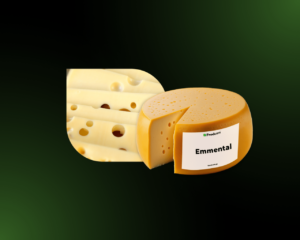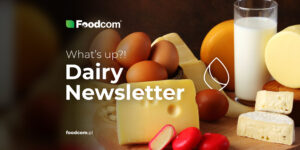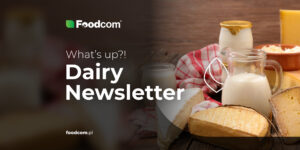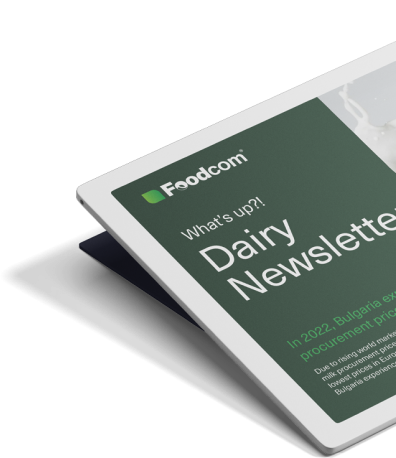- Butter is becoming cheaper, but cheese and milk powder prices are stable and WPI is reaching record levels.
- Algeria is influencing the market by announcing a large tender for SMP and WMP, which could change global milk powder prices.
- Ireland is recovering from a decline, with a record increase in milk production at the end of the year despite a difficult start.
- Brazil is focusing on cheese, planning to open 5-10 cheese schools to improve the quality and diversity of local production.
Welcome Partners!
Welcome back to our newsletter!
The dairy market remains volatile, with skimmed milk powder (SMP) maintaining stable prices despite minor adjustments, cheese prices remaining steady and the butter market showing signs of weakening due to an increase in seasonal milk production. Whey protein isolate (WPI) continues its record highs, while cream prices show varying movements by region.
Meanwhile, a large tender in Algeria could affect SMP and whole milk powder (WMP) prices, and Brazil’s collaboration with France is set to reshape the cheese sector. With changing demand and fluctuating production, will the market stabilise or face further turbulence?
Let’s take a look at what has been happening in the dairy market recently!
Milk powder
The European skimmed milk powder (SMP) market remains stable, with food-grade SMP prices hovering around 2500-2550 EUR/MT, recording a slight downward correction compared to previous weeks. Fresh product maintains a price of 2550 EUR/MT, while older batches are available slightly cheaper. Supply remains limited, supporting price stability.
Wholesale feed grade SMP remains at 2450 EUR/MT, with confirmed deals for Q1 and Q2 at 2500 EUR/MT DAP NL or higher. With the increase in seasonal milk volumes, market participants are keeping a close eye on potential changes in supply that may affect prices in the coming months.
Algeria, through the government’s O.N.I.L, has re-entered the market with a tender for SMP and WMP for supply between May and August. Negotiations are ongoing and the outcome could affect market sentiment and prices in the coming months.
Cheese
The cheese market in Europe remains stable with prices holding up. Gouda and edam remain unchanged at 4400 EUR/MT and 4300 EUR/MT respectively. Cagliata and mozzarella prices also remain at last week’s levels.
Cheddar prices remain at 4900-5000 EUR/MT and producers are actively contracting for Q2. However, buyers are showing caution in making early commitments in anticipation of a possible weakening of prices due to increasing milk supply. Despite strong demand, cheese producers are monitoring milk fat prices – further declines could affect the profitability of cheese production.
Fats
European butter prices weakened slightly, falling to 7200 EUR/MT from the previous 7350 EUR/MT. Q2 contracts have seen bids of 6750-6900 EUR/MT, reflecting a downward adjustment due to rising seasonal milk production. Deliveries for February-March are in the range of 7050-7200 EUR/MT, in line with bids from Germany, the Netherlands and Belgium. In Poland, offers below 6900 EUR/MT were observed for immediate deliveries.
Prices for anhydrous milk fat (AMF) fell last week in Poland and Western Europe, with offers ranging from 8500-8700 EUR/MT, depending on the producer. Availability remains high, providing stability in supply. Market participants are monitoring whether the downward trend will continue in the coming weeks.
Fluids
The cream market is showing signs of an upward correction, with cream of German origin quoted in the 8100-8200 EUR/MT FCA Germany range. Seasonal milk supply is increasing, although its impact on cream availability is gradual. In Poland, cream prices fell last week, reflecting local market adjustments.
Concentrated skimmed milk (SMC) prices have increased, with German products quoted in the range of 2100-2200 EUR/MT FCA Germany. Seasonal increases in milk production may influence further price fluctuations.
The milk market remains stable, with spot milk prices showing minimal fluctuations. Milk production is starting to increase seasonally, but producer payments are decreasing slightly, which the market is watching for an impact on dairy prices.
Whey powder
The whey powder market in Europe remains stable, with food grade SWP holding at 1100 EUR/MT and feed grade SWP in the 910-950 EUR/MT range. DAP NL wholesale feed whey is quoted at 925-950 EUR/MT for Q1 and Q2. Sweet whey in concentrate has shown an increase, currently trading in the 750-800 EUR/MT FCA range.
Cheese production is expected to increase in Q2, which could have a downward effect on whey prices, putting pressure on SWP in the coming months.
Meanwhile, WPC80 instant remains at around 11000 EUR/MT, reflecting stable demand and limited availability. The whey protein isolate (WPI) market remains extremely tight, with prices reaching 21000 EUR/MT and demand outstripping supply.
What else?
Oceania
Australian dairy farmers are grappling with lower farmgate milk prices this season, despite a notable 17% rise in global dairy prices since mid-2024. The average southern farmgate price currently sits at $8.20 per kilogram of milk solids – down 14% from last year – while New Zealand’s Fonterra has responded more aggressively, raising its payout forecast by 25%. Although some Australian processors, including Fonterra, Bega, and Saputo, have implemented small price increases of 15 cents per kilogram, others remain stagnant, leaving many farmers struggling with financial pressures.
Industry analysts anticipate a potential narrowing of the price gap by mid-2025 as global supply tightens, forcing local processors to reassess their pricing strategies. However, with the slow response from key market players, Australian dairy farmers continue to face economic strain, hoping for more timely and substantial price adjustments in the coming months.
Europe
Irish dairy farmers faced a tough start to 2024, with milk production dropping nearly 18% in January due to poor weather affecting grass growth and herd yields. The decline continued into spring, with April’s output falling 7.5%, marking the first time in years that peak-season production dipped below 1 million tonnes. Rising input costs and market volatility added further pressure on the sector.
However, an extended grazing season in late summer led to a strong recovery. By October, production surged 14.8%, and the final two months saw output jump over 30% year-over-year. This late rebound brought total annual milk production to 8.43 billion liters, just 0.4% below 2023 levels. Despite early setbacks, Ireland maintained strong dairy exports, shipping 1.6 million tonnes worth €6.3 billion.
South America
In January, a workshop was held with representatives of the Secretariat of Agriculture (SAA), producers and French experts such as Professor Maxence Virelaude. The meeting discussed a plan to set up between five and 10 cheese schools in Brazil, with an emphasis on adapting programmes to regional specificities and production hygiene.
The state of São Paulo, which is the largest consumer of cheese in Brazil, has more than 5 000 producers of the product. Daniel Gomes, director general of the Paulista Agency for Agribusiness Technology (APTA), stressed that the partnership with the French embassy and the private sector will contribute to increasing the diversity and quality of local cheese production. The plan is to set up five training centres in public facilities in cities such as Pindamonhangaba, Santa Cruz do Rio Pardo, Cerqueira César, Presidente Prudente and Campinas, with the possibility of expanding the project to other regions in collaboration with the private sector.
![Stability or fluctuations? What is happening to global dairy prices? [256th DAIRY Newsletter Edition] Stability or fluctuations? What is happening to global dairy prices? [256th DAIRY Newsletter Edition]](https://foodcom.pl/wp-content/uploads/2024/05/Foodcom_SA_Dairy_Newsletter_1-1520x760.jpg)






